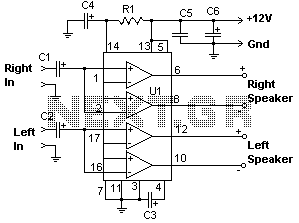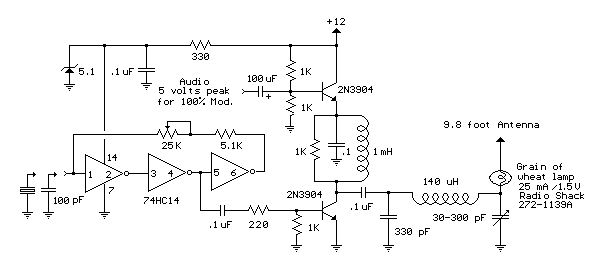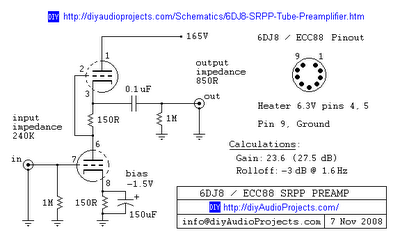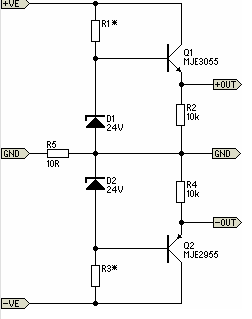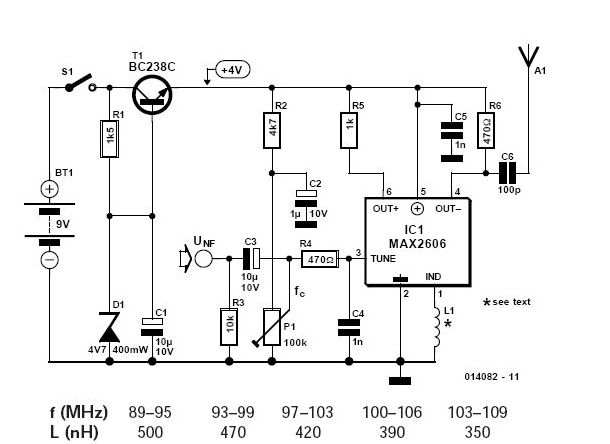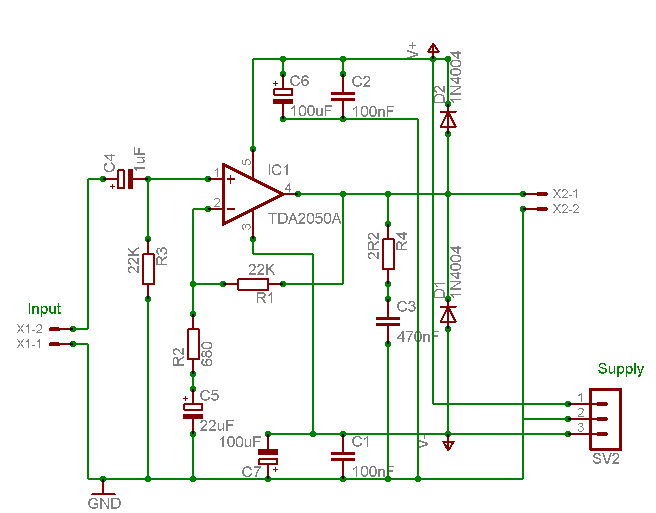
simple tv audio video transmitter
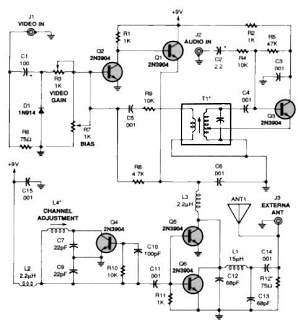
A simple TV audio-video transmitter circuit can be constructed using this schematic diagram. This circuit allows for the transmission of video signals from a VCR or other devices to a TV without the need for cables. The video signals input at jack J1 are initially terminated by resistor R6 and then coupled through capacitor C1 to the clamping diode D1. Potentiometer R3 is utilized to adjust the gain of the video signal, functioning similarly to the contrast control on a television set. The bias-control resistor R7 can be used to modify the black level of the picture, ensuring that some level of signal is transmitted even for completely dark images. The RF transformer T1 and its internal capacitor create the tank circuit of a Hartley oscillator, which is tuned to 4.5 megahertz. Audio signals input at jack J2 are coupled to the base of transistor Q3 via capacitor C2 and resistor R4, allowing the audio signal to modulate the base signal of Q3 to generate an audio subcarrier that is 4.5 megahertz higher than the video carrier frequency. The frequency-modulated subcarrier is then fed to the modulator section through capacitor C5 and resistor R9, where resistor R9 adjusts the subcarrier level relative to the video signal. Transistors Q1 and Q2 are responsible for amplitude-modulating both the video and audio signals onto an RF carrier signal. The operating frequency is determined by coil L4, which consists of 3.5 turns of 24-gauge enameled wire wound on a form containing a standard ferrite slug. The RF output from the oscillator (comprising L4, C7, and C9) is amplified by transistors Q5 and Q6, which are powered by the modulator supply voltage. Antenna matching and low-pass filtering are achieved using capacitors C12, C13, and inductor L1. Resistor R12 is optional and can be added to assist in matching the output signal to various types of antennas. To align this audio-video transmitter, the TV receiver should be tuned to an unused channel between 2 and 6. It is essential to connect an indoor antenna directly to the TV, as outdoor antennas or cable connections will not function. Both potentiometers (R3 and R7) should be set to their midpoint, and power should be applied to the transmitter. Adjust coil L4 with a non-metallic tool until the TV screen goes blank, then fine-tune L4 for the "most-blank" picture. Connect the video and audio outputs from a VCR (or other AV source) to jacks J1 and J2 of the transmitter, respectively. A picture should appear on the TV screen; if it does, readjust L4 for optimal picture quality. If no picture appears, inspect the circuit board for any faulty connections. Subsequently, adjust potentiometer R3 for the best picture brightness and R7 for overall picture quality. Finally, adjust transformer T1 with a non-metallic tool for optimal sound quality. The TV transmitter is capable of combining line-level audio and video signals, transmitting the resulting signal up to 300 feet. The circuit can be powered by a 9-12V power supply.
This schematic represents a straightforward yet effective solution for wireless audio-video transmission. The circuit's design emphasizes the importance of component selection and tuning for achieving optimal performance. The use of a Hartley oscillator allows for stable frequency generation, while the modulation stages ensure that both audio and video signals are effectively combined and transmitted. The inclusion of adjustable components, such as potentiometers and optional resistors, provides flexibility for fine-tuning the circuit to meet specific requirements. Proper alignment and setup are crucial for achieving the best results, making this circuit suitable for applications where cable connections are impractical. The range of up to 300 feet makes it a versatile choice for various home entertainment setups, ensuring that users can enjoy their media without the clutter of wires.A very simple TV audio video transmitter circuit can be designed using this schematic diagram. This TV audio video transmitter circuit can be used to transmit video signals from VCR ( or some other device ) to a TV without using any cable. Video signals input at jack J1 are first terminated by resistor R6 and coupled through capacitor C1 to clamp
ing-diode D1. Potentiometer R3 is used to set the gain of the video signal; its effect is similar to that of the contrast control on a TV set. Bias-control R7 can be used to adjust the black level of the picture so that some level of signal is transmitted, even for a totally dark picture.
RF-transformer T1 and its internal capacitor form the tank circuit of a Hartley oscillator that`s tuned to 4. 5 megahertz. Audio signals input at J2 are coupled to the base of Q3 via C2 and R4: the audio signal modulates the base signal of Q3 to form an audio subcarrier thats 4.
5-megahertz higher than the video-carrier frequency. The FM modulated subcarrier is applied to the modulator section through C5 and R9. Resistor R9 adjusts the level of the subcarrier with respect to the video signal. Transistors Q1 and Q2 amplitude modulate the video and audio signals onto an RF-carrier signal. The operating frequency is set by coil L4, which is 3. 5 turns of 24- gauge enameled wire on a form containing a standard ferrite slug. The RF output from the oscillator (L4, C7 and C9 ) section is amplified by Q5 and Q6, whose supply voltage comes from the modulator. Antenna matching and low-pass filtering is performed by C12, C13, and L1. Resistor R12 is optional; it is added to help match the output signal to any kind of antenna. To align this audio video transmitter you need to tune a TV receiver to an unused channel between 2 and 6.
The TV must have an indoor antenna connected irectly to it; an outdoor antenna or cable won`t work. Make sure both otentiometers (R3, R7) are in middle position and apply power to the transmitter. Adjust L4 with a nonmetallic tool until the TV screen goes blank, then fine-adjust L4 for the "most-blank" picture. Connect the video and audio outputs from a VCR(AV source) to jacks J1 and J2 (respectively) of the transmitter.
After that you should see a picture on the TV screen: if you do, readjust L4 for the best picture; if you don`t, check the board for any bad connections. Next, adjust R3 for the best picture brightness and R7 for the best overall picture. Finally, adjust T1 with a nonmetallic tool for the best sound. The TV transmitter combines line level audio and video signals, and transmits the resulting signl up to 300 feet.
The circuit can be powered from a 9-12V power supply circuit. 🔗 External reference
This schematic represents a straightforward yet effective solution for wireless audio-video transmission. The circuit's design emphasizes the importance of component selection and tuning for achieving optimal performance. The use of a Hartley oscillator allows for stable frequency generation, while the modulation stages ensure that both audio and video signals are effectively combined and transmitted. The inclusion of adjustable components, such as potentiometers and optional resistors, provides flexibility for fine-tuning the circuit to meet specific requirements. Proper alignment and setup are crucial for achieving the best results, making this circuit suitable for applications where cable connections are impractical. The range of up to 300 feet makes it a versatile choice for various home entertainment setups, ensuring that users can enjoy their media without the clutter of wires.A very simple TV audio video transmitter circuit can be designed using this schematic diagram. This TV audio video transmitter circuit can be used to transmit video signals from VCR ( or some other device ) to a TV without using any cable. Video signals input at jack J1 are first terminated by resistor R6 and coupled through capacitor C1 to clamp
ing-diode D1. Potentiometer R3 is used to set the gain of the video signal; its effect is similar to that of the contrast control on a TV set. Bias-control R7 can be used to adjust the black level of the picture so that some level of signal is transmitted, even for a totally dark picture.
RF-transformer T1 and its internal capacitor form the tank circuit of a Hartley oscillator that`s tuned to 4. 5 megahertz. Audio signals input at J2 are coupled to the base of Q3 via C2 and R4: the audio signal modulates the base signal of Q3 to form an audio subcarrier thats 4.
5-megahertz higher than the video-carrier frequency. The FM modulated subcarrier is applied to the modulator section through C5 and R9. Resistor R9 adjusts the level of the subcarrier with respect to the video signal. Transistors Q1 and Q2 amplitude modulate the video and audio signals onto an RF-carrier signal. The operating frequency is set by coil L4, which is 3. 5 turns of 24- gauge enameled wire on a form containing a standard ferrite slug. The RF output from the oscillator (L4, C7 and C9 ) section is amplified by Q5 and Q6, whose supply voltage comes from the modulator. Antenna matching and low-pass filtering is performed by C12, C13, and L1. Resistor R12 is optional; it is added to help match the output signal to any kind of antenna. To align this audio video transmitter you need to tune a TV receiver to an unused channel between 2 and 6.
The TV must have an indoor antenna connected irectly to it; an outdoor antenna or cable won`t work. Make sure both otentiometers (R3, R7) are in middle position and apply power to the transmitter. Adjust L4 with a nonmetallic tool until the TV screen goes blank, then fine-adjust L4 for the "most-blank" picture. Connect the video and audio outputs from a VCR(AV source) to jacks J1 and J2 (respectively) of the transmitter.
After that you should see a picture on the TV screen: if you do, readjust L4 for the best picture; if you don`t, check the board for any bad connections. Next, adjust R3 for the best picture brightness and R7 for the best overall picture. Finally, adjust T1 with a nonmetallic tool for the best sound. The TV transmitter combines line level audio and video signals, and transmits the resulting signl up to 300 feet.
The circuit can be powered from a 9-12V power supply circuit. 🔗 External reference
